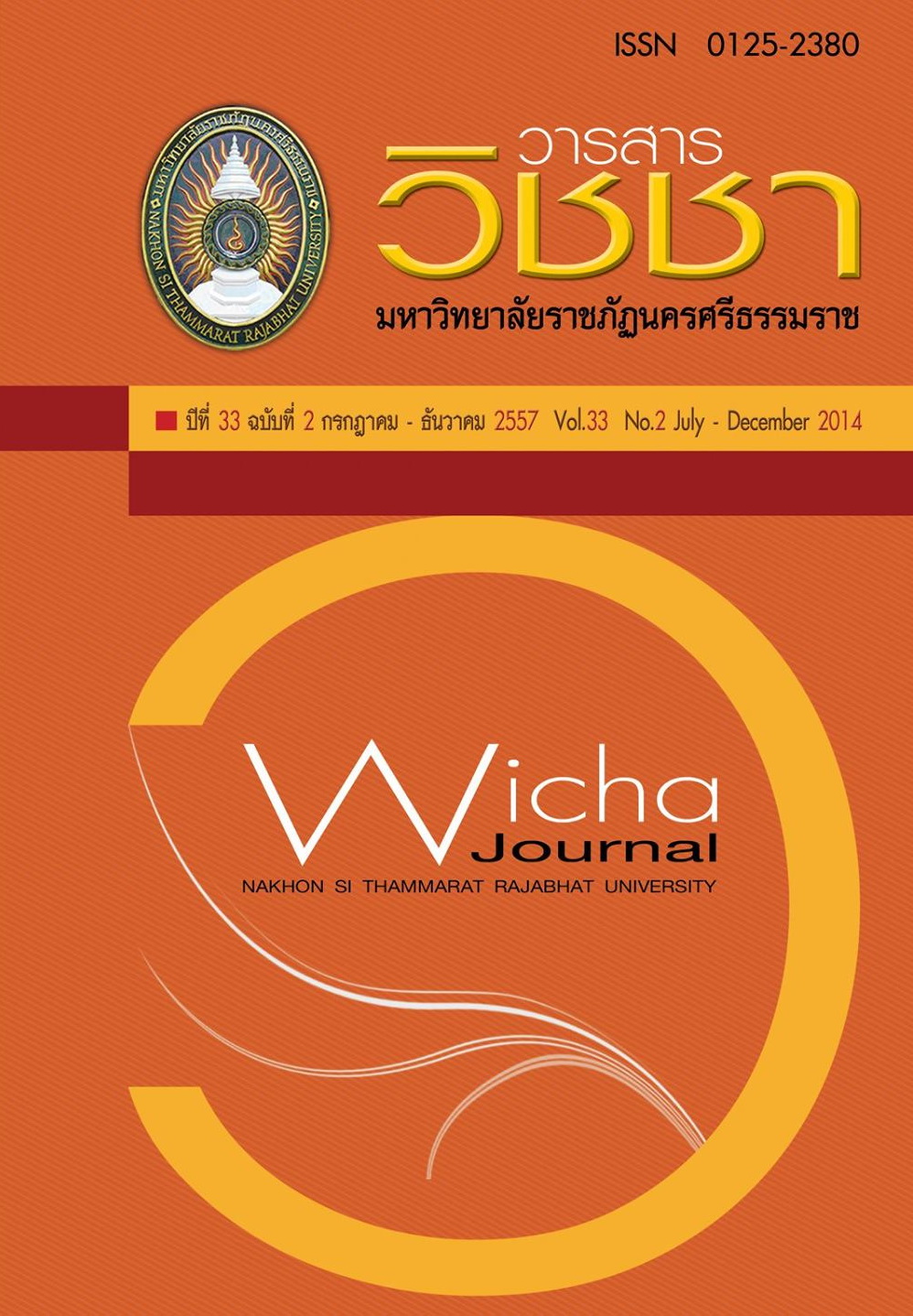การผลิตเส้นใยเซลลูโลสด้วยน้ำหวานต้นจาก
Main Article Content
Abstract
งานวิจัยนี้มีวัตถุประสงค์เพื่อศึกษาปัจจัยที่มีผลต่อความหนา และปริมาณผลผลิตของเส้นใยเซลลูโลสที่หมักด้วยน้ำหวานจาก ได้แก่ ระดับความเข้มข้นของน้ำหวานจาก ปริมาณแอลกอฮอล์แมกนีเซียมซัลเฟต กรดอะซิติก และการปรับค่าพีเอชของน้ำหมัก โดยทำการทดลองในกล่องพลาสติกขนาด 14x7x7 ลูกบาศก์เซนติเมตร ปิดฝาด้วยกระดาษปลอดเชื้อ เติมหัวเชื้อ Acetobacter xylinum 10% หมักที่อุณหภูมิห้องเป็นระยะเวลา 10 วัน พบว่า สูตรที่เหมาะสมในการผลิตเส้นใยเซลลูโลสด้วยน้ำหวานจาก คือน้ำหวานจากความเข้มข้น 10 oBrix แอมโนเนียฟอสเฟต 0.5% กรดอะซิติก 0.4% แมกนีเซียมซัลเฟต 0.1% และปรับพีเอชเป็น 5.5 ด้วยกดอะซิติก หมักเป็นระยะเวลา 10 วัน ที่อุณหภูมิห้อง จะได้เส้นใยเซลลูโลสที่มีความหนาและผล ผลิตสูงสุดเท่ากับ 1.56+0.02 เซนติเมตรและ 99.81+0.31% ตามลำดับ เมื่อเปรียบเทียบกับเส้นใยเซลลูโลสที่ผลิตด้วยน้ำมะพร้าวสูตรดั้งเดิม พบว่ามีความหนาและผลผลิตเท่ากับ 1.36 เซนติเมตร และ 81.9% ตามลำดับ เมื่อนำมาผลิตเป็นวุ้นในน้ำเชื่อม ทำการทดสอบความแตกต่างทางประสาทสัมผัสด้านสีความนุ่ม กลิ่น เนื้อสัมผัส และความชอบรวม พบว่า เส้นใยเซลลูโลสที่ผลิตด้วยน้ำหวานจากและน้ำมะพร้าวสูตรดั้งเดิม มีความแตกต่างกันเล็กน้อยถึงปานกลาง (2.5-3.0) และผู้บริโภคให้การยอมรับเส้นใยเซลลูโลสที่ผลิตด้วยน้ำหวานจากมากกว่าแบบที่ผลิตโดยใช้น้ำมะพร้าว
Production of Bacterial Cellulose from Nipa Palm Sap
The purpose of this research was to instigate factors affecting thickness and yield of bacterial cellulose product from Nipa palm sap such as the concentrations of Nipa palm sap, alcohol, magnesium sulphate, acetic acid and pH adjustment of the fermentation. The fermentation was contained out a plastic box (14x7x7 cm3) covered with aseptic paper by inoculation with Acetobacter xylinum 10% and incubated at room temperature for a period of 10 days.
This study found that appropriate formula for bacterial cellulose production with Nipa palm sap was 10 o Brix Nipa palm sap, 0.5% ammonia phosphate, 0.4% acetic acid and 0.1% magnesium sulfate with pH adjusted to 5.5 using acetic acid. After fermentation at room temperature of 10 days, the obtained bacterial cellulose thickness and yield was 1.56+0.02 cm and 99.8+0.31% respectively. Where the thickness and yield of bacterial cellulose product from coconut water was 1.36 cm and was 81.9%, respectively.
Subsequently, the bacterial cellulose was used to produce bacterial cellulose in the syrup sensory evaluation in teams of color, odor, texture, tenderness and overall acceptability was conducted. If was frond that the bacterial cellulose produced by Nipa palm sap and coconut water was slightly moderately different 2.5 to 3.0 and Bacterial cellulose produced with Nipa palm sap was acceptable by the consumers than that produced with coconut water.
Article Details
เนื้อหาและข้อมูลในบทความที่ลงตีพิมพ์ในวารสารวิชชา มหาวิทยาลัยราชภัฏนครศรีธรรมราช ถือเป็นข้อคิดเห็นและความรับผิดชอบของผู้เขียนบทความโดยตรง ซึ่งกองบรรณาธิการวารสารไม่จำเป็นต้องเห็นด้วยหรือร่วมรับผิดชอบใด ๆ
บทความ ข้อมูล เนื้อหา รูปภาพ ฯลฯ ที่ได้รับการตีพิมพ์ในวารสารวิชชา มหาวิทยาลัยราชภัฏนครศรีธรรมราช ถือเป็นลิขสิทธ์ของวารสารวิชชา มหาวิทยาลัยราชภัฏนครศรีธรรมราช หากบุคคลหรือหน่วยงานใดต้องการนำข้อมูลทั้งหมดหรือส่วนหนึ่งส่วนใดไปเผยแพร่ต่อหรือเพื่อการกระทำการใด ๆ จะต้องได้รับอนุญาตเป็นลายลักษณ์อักษรจากวารสารวิชชา มหาวิทยาลัยราชภัฏนครศรีธรรมราชก่อนเท่านั้น
The content and information in the article published in Wichcha journal Nakhon Si Thammarat Rajabhat University, It is the opinion and responsibility of the author of the article. The editorial journals do not need to agree. Or share any responsibility.


